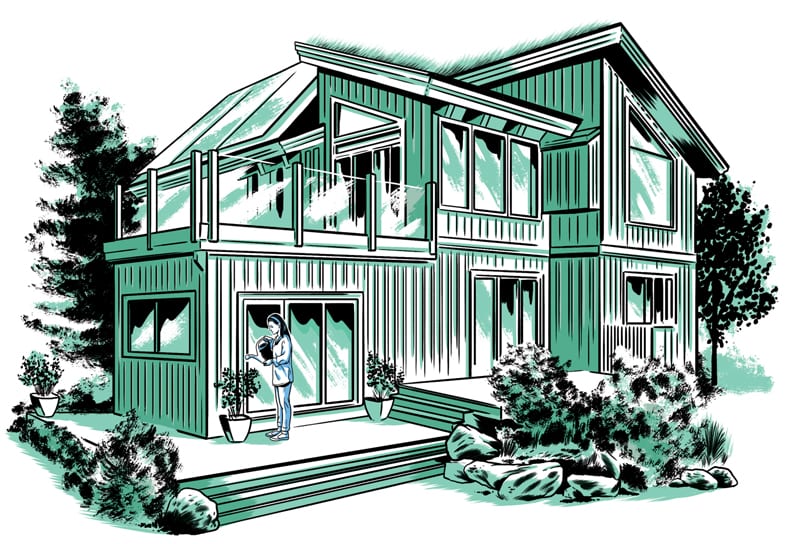Ted Landsmark Shares what Residential Design Might Look Like Post 2020
January 11, 2021
Text by Ted Landsmark, M.Env.D., J.D., Ph.D.,

Illustration by Joel Kimmell
Past pandemics led to the development of residential courtyards and public parks, smaller rooms, isolating interiors, sanitation reform, and workers’ housing. So, what can designers and their clients learn from the health and social challenges raised by COVID-19 and the Black Lives Matter movement? Perhaps innovative and renewed solutions to divisive environmental issues can be explored with light technological impacts, while developing new community-wide approaches to support social justice.
Let’s start with smart homes. Family health and safety can achieve increased importance in these high-tech spaces. New approaches to healthful landscape and entry designs may include “smart” surveillance and hygienically “screened” porches with energy-efficient natural-light orientations. Front door overhangs could be extended, and foyers, drop-off vestibules, and mudrooms reconfigured to facilitate new patterns of food and commodity deliveries. Storage and utility spaces could incorporate dedicated renewable-energy-derived vehicle
charging stations.
Now is the time to reconfigure food preparation, eating, and wet spaces, too. Self-regulating appliances with touchless controls, as well as renewable energy sources, anti-microbial surfaces, and locally sourced materials will find increased uses. Appliances like bidets are already becoming more popular. “Greener” design can emerge with resilient, interconnected, and redundant utility systems, such as back-up power sources, to make homes health-and disaster-defensible sanctuaries, all with the goal of supporting community well-being.
Open-layout concepts have reigned supreme recently, but it might be time to rethink those. Interior designers are considering smaller rooms with transparent dividers, comparable to the French doors and pocket walls of earlier eras, where semi-private and isolated work/study spaces enhance healthy households through selective social distancing. Separate in-law units, digitized fabrication spaces (think the garage workshop space of the future), child play areas, and quiet meditative rooms could become highly desirable.
As the weather warmed last year, we witnessed outdoor living take on even greater importance as families attempted to see each other in a safe manner. Is the creation of separate backyard buildings with sleeping and water-closet access and multi-purpose spaces on the horizon? What about new solutions for reducing congregate density in luxury urban housing? Greater attention will be paid to air handling with separable environmental systems, opening windows, and health-care infrastructures.
COVID-19 and Black Lives Matter catalyzed a reconsideration of how we attend to health and social justice. Black Lives Matter highlighted who may need affordable housing near centers of luxurious living. We now rarely accommodate the needs of workforce housing and transportation as industrialists did during the nineteenth century, but questions of where support workers live require a reconsideration of current zoning and building codes to encourage the development of nearby affordable housing. Some communities are developing dedicated revenue sources to offset post-pandemic revenue declines, in order to support affordable housing. Here in New England, Boston initiated a community preservation fund to support affordable housing, historic preservation, public recreation, and open space.
Living with refined spatial aesthetics does not preclude designing to high standards of resilience, health, and social equity. Our desire for autonomy has contributed to the U.S. having the highest per capita energy usages and COVID-19 death rates in the world, heavily impacting frontline service workers. Right now, in 2021, we have the opportunity to re-envision our lifestyle expectations for our landscapes, homes, work and play spaces, learning environments, transportation, and renewable energy systems. We are learning to design more interactive, healthy, and resilient relationships with nature and with one another.
Ted Landsmark, M.Env.D., J.D., Ph.D., is director of the Dukakis Center for Urban and Regional Policy at Northeastern University, president emeritus of the Boston Architectural College, and a member of the Board of the Boston Planning & Development Agency.
Share
![NEH-Logo_Black[1] NEH-Logo_Black[1]](https://b2915716.smushcdn.com/2915716/wp-content/uploads/2022/08/NEH-Logo_Black1-300x162.jpg?lossy=1&strip=1&webp=1)









You must be logged in to post a comment.